商务英语综合教程4 Unit1
- 格式:ppt
- 大小:18.42 MB
- 文档页数:36
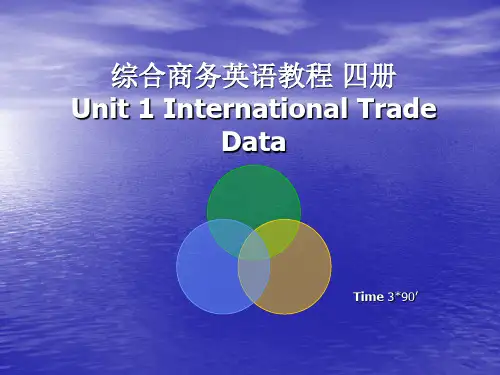
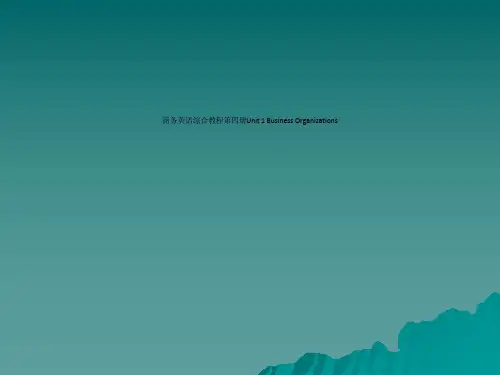
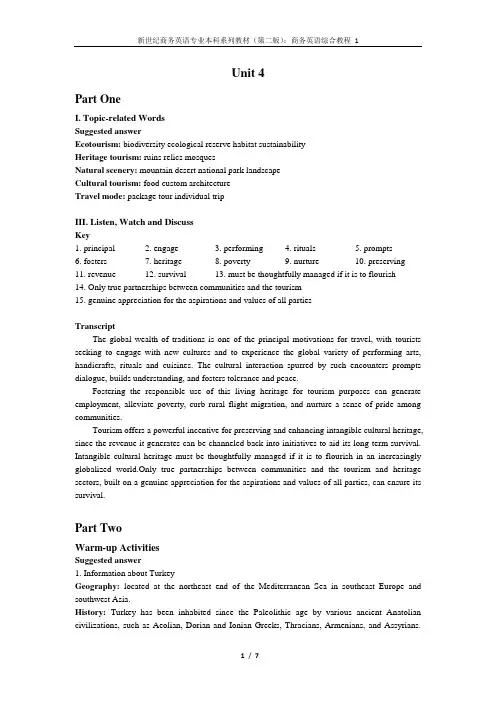
Unit 4Part OneI. Topic-related WordsSuggested answerEcotourism: biodiversity ecological reserve habitat sustainabilityHeritage tourism: ruins relics mosquesNatural scenery: mountain desert national park landscapeCultural tourism: food custom architectureTravel mode: package tour individual tripIII. Listen, Watch and DiscussKey1. principal2. engage3. performing4. rituals5. prompts6. fosters7. heritage8. poverty9. nurture 10. preserving 11. revenue 12. survival 13. must be thoughtfully managed if it is to flourish14. Only true partnerships between communities and the tourism15. genuine appreciation for the aspirations and values of all partiesTranscriptThe global wealth of traditions is one of the principal motivations for travel, with tourists seeking to engage with new cultures and to experience the global variety of performing arts, handicrafts, rituals and cuisines. The cultural interaction spurred by such encounters prompts dialogue, builds understanding, and fosters tolerance and peace.Fostering the responsible use of this living heritage for tourism purposes can generate employment, alleviate poverty, curb rural flight migration, and nurture a sense of pride among communities.Tourism offers a powerful incentive for preserving and enhancing intangible cultural heritage, since the revenue it generates can be channeled back into initiatives to aid its long-term survival. Intangible cultural heritage must be thoughtfully managed if it is to flourish in an increasingly globalized world.Only true partnerships between communities and the tourism and heritage sectors, built on a genuine appreciation for the aspirations and values of all parties, can ensure its survival.Part TwoWarm-up ActivitiesSuggested answer1. Information about TurkeyGeography: located at the northeast end of the Mediterranean Sea in southeast Europe and southwest Asia.History: Turkey has been inhabited since the Paleolithic age by various ancient Anatolian civilizations, such as Aeolian, Dorian and Ionian Greeks, Thracians, Armenians, and Assyrians.The Persian Empire occupied the area in the 6th century B.C., giving way to the Roman Empire, then later the Byzantine Empire. The Ottoman Turks first appeared in the early 13th century, and gradually spread through the Near East and Balkans, capturing Constantinople in 1453. After the reign of Sultan Suleiman I the Magnificent (1494—1566), the Ottoman Empire began to decline. In the nineteenth century, Turkey was occupied by Russia, but the Turkish War of Independence (1919—1922) resulted in the establishment of the modern Republic of Turkey in 1923.Politics: Turkey is a parliamentary representative democracy.Economy: Turkey has the world’s 17th largest GDP by PPP and 18th largest nominal GDP. The country is among the founding members of the OECD and the G-20 major economies. Religion: Islam is the dominant religion of Turkey with 99.8 percent of the population being registered as Muslim.2. Ancient civilizationsRoman civilization began on the Italian Peninsula as early as the 8th century BC and shifted from a monarchy to a republic and then to an empire. As a highly developed civilization, Ancient Roman has contributed a lot to modern government, law, politics, engineering, art, literature, architecture, technology, warfare, religion, language and society.Persian civilization is a series of imperial dynasties centered in Persia (Iran), the first of which was established by Cyrus the Great in 550 BC, with the Persian conquest of Media, Lydia and Babylonia.Byzantine civilization is the continuation of the Roman Empire in the East during Late Antiquity and the Middle Ages, when its capital city was Constantinople (modern-day Istanbul, originally founded as Byzantium). It survived the fragmentation and fall of the Western Roman Empire in the 5th century AD and continued to exist for an additional thousand years until it fell to the Ottoman Turks in 1453. During most of its existence, the empire was the most powerful economic, cultural, and military force in Europe.Modern historians distinguish Byzantium from ancient Rome insofar as it was centered on Constantinople, oriented towards Greek rather than Latin culture, and characterized by Orthodox Christianity.The Ottoman Empire, which is also known as the Turkish Empire or Turkey, was an empire founded in 1299 by Oghuz Turks under Osman I in northwestern Anatolia. With conquests in the Balkans by Murad I between 1362 and 1389, the Ottoman sultanate was transformed into a transcontinental empire and claimant to caliphate. The Ottomans overthrew the Byzantine Empire with the 1453 conquest of Constantinople (present-day Istanbul) by Mehmed the Conqueror.The Neo-Assyrian Empire was an Iron Age Mesopotamian empire, in existence between 911 and 609 BC. Following the reforms of Tiglath-Pileser III in the 8th century BC, Assyria emerged as the most powerful state of the Ancient Near East, eclipsing Babylonia and Egypt. The Neo-Assyrian Empire succeeded the Middle Assyrian period of the Late Bronze Age. During this period, Aramaic was also made an official language of the empire, alongside the Akkadian language.Text IComprehension CheckI. Reading for general ideas1. Fill in the blanks to complete the outline of the text.KeyMain Idea: The threat to an ancient town with a long history and many treasures, and local people’s attitudes towards it.Heading for Part I (Paragraph 1): Arrival in town and encounter with ShepherdsHeading for Part II (Paragraphs 2 to 3): The history of and treasures in HasankeyfHeading for Part III (Paragraphs 4 to 5): The threat posed by development and concerns Heading for Part IV (Paragraphs 6 to 12): Local dwellers’ hospitality and their attitudes towards the Dam ProjectHeading for Part V (Paragraphs 13—15): The nostalgia, and possible way out for the local people in face of change2. Read the text through quickly and answer the following questions.Key1.Hasankeyf is a small town located in the Batman province of southeast Turkey, not far fromthe border with Syria and, further down, Iraq. It is famous for its long history, more than 300 historical monuments and thousands of ancient human-made caves.2.The treasures in Hasankeyf are facing the threat that by the end of 2015, the massive135m-high and 1,820m-wide Ilisu Dam is projected to force many of Hasankeyf’s sites under water, including the Great Palace and the caves.3.The government has plans to create an archaeological park by relocating some of themonuments to higher ground. The ones that cannot be moved will become an underwater diving park.4.No, not for everyone. Even with these plans, many historians, scientists and archaeologists areconcerned that another Troy or Mycenae may remain lost forever since much of the area has yet to be excavated.5.Some of the local dwellers, such as the patriarch and his family, are strongly against it. Theyhave lived here for f ive generations and they are happy here. They don’t want to leave this place.II. Reading for specific informationKey1. F2. F3. F4. T5. F6. TIII. Reading and making interpretationsSuggested answer1.Even though the government has made plans to save the historical monuments, manyhistorians, scientists and archeologists still feel worried because there are many places which have not been dug yet and maybe there are some important ancient relics which have not been found yet underground. If this happens, it means some important relics as ancient as Troy or Mycenae will be lost forever.2.When I was together with the cave-dwellers, I asked permission to milk their sheep, butwithout success, and they laughed at my failure. When their laughter was not so loud, we changed our topic and began to talk about the dam.3.The shepherds’ truck was in very poor condition and I rode in it with the crowd, crossed ariver which was not deep and arrived at the shepherd’s home. We called it cave, but I did not think cave was the proper word for it.4.The cave was two storeys high, very spacious, with beautiful decoration and running water,electricity and even a glass pane window. It was a place I would like to have. The floor in the living room was covered by thick carpets, which was lined with comfortable cushions.5. A lot of things happened here: wars, earthquakes and conquests. Some of them brought gloryto this place and some brought decline. But no matter what happened, these ancient monuments still stand here and the people still live around them. They have lived longer than those historical events.Part ThreeText IIComprehension CheckI. Reading for specific information1. Fill in the blanks to complete the outline of the text.1.Over the last 30 years international tourism to developing countries has increased enormouslyand one in five international flights now goes to a developing country.2.The park systems in most developing countries are failing to invest at anywhere near thenecessary levels to build capacity for managing the growth in park visits. As a result, tourism is now a threat to biodiversity rather than a benefit. The over-crowdedness of international nature tourism destinations will not only lead to a decline in the quality of the visitor experience, but also have a great impact on the fauna and flora in the destinations.3.On one hand, the destinations should focus on developing financial opportunities and boostingrevenues; on the other hand, the revenues must be reinvested appropriately at the specific sites that generate them, at least at a level adequate to prevent loss of natural capital.4.On one hand, the park systems should get more from the tourism income. On the other hand,they can raise the tickets prices.5.It starts a virtuous cycle: protected areas are more clearly perceived as assets for economicdevelopment, and investments are made in improved tourism management, which in turn leads to more visits and less poverty.II. Reading and making interpretationsSuggested answer1.Now there is a huge gap between the current estimate of spending on protected area indeveloping countries and the lowest expenditure needed to provide effective conservation and management of their resources. If there is proper policy to control the development of nature tourism and ecotourism, it could help greatly in reducing the wide gap.2.Judging by appearance, tourism should be good business to developing countries in all aspects,because it can make tourists happy, bring more revenues to the park systems and increase investment in conservation.3.If investment remains inadequate, tourism will probably cease to prosper soon and becomedifficult to develop.4.On one hand, the conservationists need to deal with the environmental threats caused bytourism development; on the other hand, they should also concentrate on developing tourism in order to bring more economical development.5.According to the financial estimate, if investment is increased, there will be greater demand intourism. The Ecuadorian tourism industry has shown that they are ready to support such initiatives after analyzing the financial estimate.Part FourText IIIQuestions for group discussionSuggested answer1.The text is taken from a travel book. It may also appear as a travelogue, part of a traveljournal or in a travel magazine.2.It gives an account of an American’s experience in the UK: his amusement, bitterness,surprise, and confusion.3.For example, the inn keeper and the man walking a dog.4.The tone of the article is humorous with slight satire. For example, the reality that he couldnot find accommodation must be very annoying to him, but he only refers it as “the only mildly dismaying thing”. Before he approached the guesthouse, he imagined a cheery conversation but was rudely refused in the first place, no chance to offer his humble apology at all. When he had nowhere to go and finally decided to sleep on the street, he referred it as “a shelter open to the elements but roofed” and “decided that this was as good as I was going to get.”Part FiveLanguage FocusFill in the blanks with the words above.1. grace 4. civilize 7. gracefully 10. hospitality2. controversy 5. controversial 8. civilized3. sustainability 6. hospitable 9. sustainableII. Idioms, phrasal verbs and fixed expressions1. in 4. of 7. with 10. about2. out 5. in 8. down3. into 6. to 9. offIII. Collocations1. meant/wished2. doing/inflicting/causing3. potential/serious/untold/irreparable/lasting/permanent4. economically/financially/physically; mentally/spiritually5. from6. through7. manage/struggle/are able/are luckyIV. Complete the following sentences with the words and phrases given in the box.1. fetching 5. contribute to 9. trudge(d) 13. bathed in2. grazing 6. mighty 10. crouch 14. sumptuous3. meager 7. status quo 11. harness 15. abundance4. yawning 8. concession 12. weather-beatenComprehensive PracticeI. Translate the following into English, using the words and phrases from the texts. Suggested answer1.As a result of deregulation and the danger to travelers it has brought about, I make up mymind that I will not make that country my travel destination in recent two years.2.We joined the tour-bus crowds in Petra to visit the ancient capital of the Nabateans and foundthat no words could do justice to the beauty and grandeur of the rose-red city of the desert. 3.Judging by the response to the upcoming trailers, this movie is bound to be another success ofthis young and promising director.4.The old man with a weather-beaten face told us: “We’re thrifty. We can live off our interest,save the principal and let the kids go off and have a hoot.”5.She wrote some controversial poems, which brought her instant fame, but the publicity soondied down over time.II. Translate the following into Chinese.Suggested answer不管度假采取何种形式,我们还是乐此不疲。

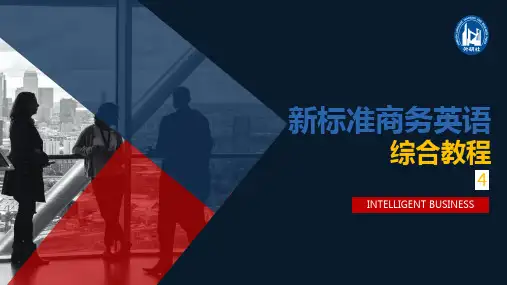
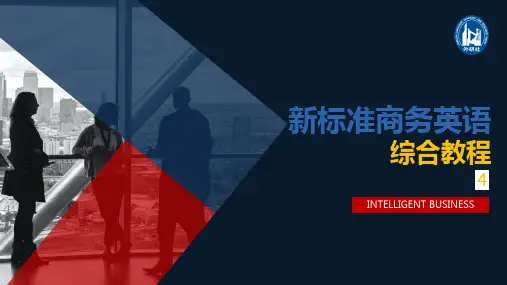
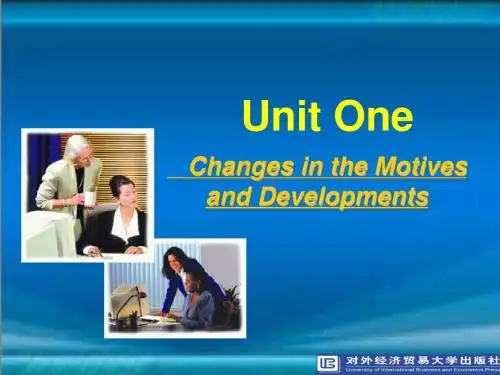
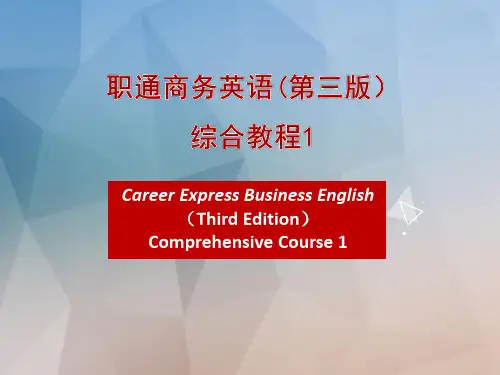

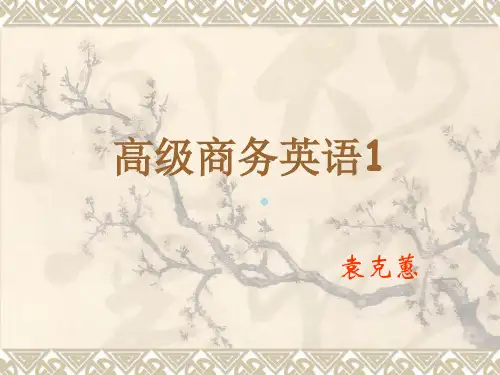
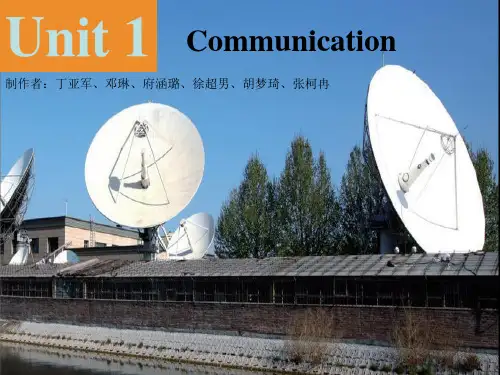
外研社新标准商务英语综合教程1New Standard Business English CourseUnit One: Introduction to Business CommunicationIn this unit, you will learn about the basics of business communication. You will learn about different types of communication tools, the purpose of communication and how to choose the right communication method and message.Communication ToolsBusiness communication can be done in many ways, including verbal and written communication. Verbal communication can happen in person or over the phone, while written communication can be in the form of emails, letters, or memos.Purpose of CommunicationThe purpose of communication is to convey information from one person or group to another. In business, the purpose of communication can be to convey information about a particular product or service, to invite someone to an event or to simply keep people informed about changes in the company.Choosing the Right Method and MessageEffective communication depends on choosing the right method and message for your intended audience. Consider your audience before choosing the method of communication and tailor yourmessage to fit their needs.Unit Two: Business WritingThis unit will focus on writing skills for business. You will learn about formal and informal writing, how to write emails, letters and memos, and how to write an effective business report.Formal and Informal WritingFormal writing is used in professional communication and requires a specific style and tone. Informal writing is used in everyday communication and tends to be less structured and more conversational.Writing Emails, Letters and MemosEmails, letters and memos are all important forms of business communication. In this unit, you will learn the key elements of each type of writing and how to write clear and effective messages.Writing a Business ReportA business report is a formal document that provides information on a particular topic. In this unit, you will learn how to structure a business report, how to collect and analyze data, and how to present your findings effectively.Unit Three: Presentations and Public SpeakingThis unit will teach you how to give effective presentations and become a confident public speaker. You will learn how to structure a presentation, create effective visuals and use body language to convey your message.Structuring a PresentationEffective presentations require careful planning and organization. In this unit, you will learn how to structure a presentation that captures your audience's attention and conveys your message effectively.Creating Effective VisualsVisual aids can enhance the impact of a presentation. In this unit, you will learn how to create effective visual aids that support your message and engage your audience.Using Body LanguageBody language is an important part of communication, especially in public speaking. In this unit, you will learn how to use body language effectively to convey confidence and professionalism.Unit Four: Negotiation SkillsThis unit will teach you the skills needed for successful negotiation in business. You will learn about negotiation styles, techniques and strategies, and how to negotiate effectively with different personalities.Negotiation Styles, Techniques and StrategiesNegotiation requires careful planning and preparation. In this unit, you will learn about different negotiation styles, techniques and strategies that can be used to achieve a successful outcome.Negotiating with Different PersonalitiesEffective negotiation requires an understanding of different personality types. In this unit, you will learn how to identify different personality types and how to adapt your negotiation style to work effectively with each personality type.Unit Five: Cross-Cultural CommunicationIn a global business environment, cross-cultural communication is essential. This unit will teach you how to communicate effectively with people from different cultures and how to avoid common cultural mistakes.Communication Across CulturesDifferent cultures have different communication styles and norms. In this unit, you will learn about different communication styles and how to adapt your own communication style to work effectively with people from different cultures.Avoiding Cultural MistakesCultural differences can lead to misunderstandings and mistakes. In this unit, you will learn how to avoid common cultural mistakes and how to communicate effectively across cultural divides.ConclusionThe New Standard Business English Course is designed to provide you with the skills and knowledge needed to communicate effectively in a business environment. The course covers a range of topics, from business writing and negotiation skills to presentations and cross-cultural communication. By completing this course, you will be well-prepared to communicate confidently and professionally in any business situation.Unit One: Introduction to Business CommunicationCommunication is essential in business, and the ability to communicate effectively can make a significant difference in the success of any endeavor. In Unit One, you will learn about the basics of business communication.The purpose of communication is to convey information from one person or group to another. In business, the purpose of communication can be to convey information about a particular product or service, to invite someone to an event, or to simply keep people informed about changes in the company. Communication can take place verbally or in written form. Verbal communication can happen in person or over the phone, while written communication can be in the form of emails, letters, or memos. Choosing the right method and message for your intendedaudience is essential for effective communication. Consider your audience before choosing the method of communication and tailor your message to fit their needs. For instance, if you are communicating with clients or customers, you may want to use more formal language. In contrast, if you are communicating with colleagues, informal language might be more appropriate.Unit Two: Business WritingEffective writing skills are essential in business. In this unit, you will learn about formal and informal writing, how to write emails, letters, and memos, and how to write an effective business report.Formal writing is used in professional communication and requires a specific style and tone. It is usually used for more official purposes and has a more structured format than informal writing. Informal writing is used in everyday communication and tends to be less structured and more conversational.Emails, letters, and memos are all important forms of business communication. In this unit, you will learn the key elements of each type of writing and how to write clear and effective messages. Writing clear emails is an essential part of business communication, as it is a quick and convenient method of communication. A well-written email can convey your message effectively and make a positive impression on the recipient.A business report is a formal document that provides information on a particular topic. In this unit, you will learn how to structure a business report, how to collect and analyze data, and how topresent your findings effectively.Unit Three: Presentations and Public SpeakingPublic speaking is a crucial skill for business professionals, and the ability to give effective presentations can be a valuable asset. In this unit, you will learn how to structure a presentation, create effective visuals, and use body language to convey your message.Effective presentations require careful planning and organization. In this unit, you will learn how to structure a presentation that captures your audience's attention and conveys your message effectively. The key elements of an effective presentation include an engaging opening, clear objectives, a compelling argument, supportive evidence, and a memorable conclusion.Visual aids can enhance the impact of a presentation. In this unit, you will learn how to create effective visual aids that support your message and engage your audience. The key to creating effective visuals is to keep them simple, relevant, and visually appealing. Body language is an important part of communication, especially in public speaking. In this unit, you will learn how to use body language effectively to convey confidence and professionalism. Effective use of body language can help you connect with your audience and build rapport, making your presentation more effective.Unit Four: Negotiation SkillsNegotiation is an essential part of business, and the ability to negotiate effectively can make a significant difference in the success of any endeavor. In this unit, you will learn about negotiation styles, techniques, and strategies, and how to negotiate effectively with different personalities.Negotiation requires careful planning and preparation. In this unit, you will learn about different negotiation styles, techniques, and strategies that can be used to achieve a successful outcome. By learning how to effectively negotiate, you can better manage conflict, build stronger relationships, and achieve mutually beneficial outcomes.Effective negotiation requires an understanding of different personality types. In this unit, you will learn how to identify different personality types and how to adapt your negotiation style to work effectively with each personality type. By understanding the different communication styles and behavior patterns, you can better navigate the negotiation process and improve your chances of success.Unit Five: Cross-Cultural CommunicationIn today's global business environment, cross-cultural communication is essential. In this unit, you will learn how to communicate effectively with people from different cultures and how to avoid common cultural mistakes.Different cultures have different communication styles and norms. In this unit, you will learn about different communication stylesand how to adapt your own communication style to work effectively with people from different cultures. By understanding cultural differences and adapting your style accordingly, you can better communicate with people from different backgrounds and build stronger relationships.Cultural differences can lead to misunderstandings and mistakes. In this unit, you will learn how to avoid common cultural mistakes and how to communicate effectively across cultural divides. By learning how to navigate cultural differences, you can better understand and engage with people from different cultures, improving your chances of success.ConclusionThe New Standard Business English Course is designed to provide you with the skills and knowledge needed to communicate effectively in a business environment. By completing this course, you will be well-prepared to communicate confidently and professionally in any business situation. With a focus on business writing, presentations and public speaking, negotiation, and cross-cultural communication, this course provides a comprehensive overview of essential skills for success in the workplace.。
Unit 4: PayThis unit looks at pay, specifically executive pay. A topical question is whether top managers and directors deserve the lavish pay packages they are awarded. This is a particularly relevant issue since the gap between executives‘ pay and that of factory-floor workers has widened in rich countries over the past two decades. The late 1990s saw a trend, particularly in the USA, towards rewarding executives with stock options and other performance-related bonuses. This has become even more controversial since some top executives continue to receive huge rewards despite poor efforts and poor results. This has enraged shareholders in Britain and the USA, who have begun to revolt against excessive executive pay packages. For example, shareholders of the pharmaceutical company GlaxoSmithKline have recently failed to approve the proposed remuneration package for the CEO. Companies are now exploring new ways to motivate their top staff. Some argue that offering employees stock options makes no sense because this only contributes to short-term thinking. Moreover, stock options are often only available to top management in a company, and are only one way of motivating a workforce. Another approach to motivating staff to stay with a company is to offer a range of flexible benefits (including extra holiday, inexpensive insurance and car leasing), which firms such as KPMG, Cadbury and Cable & Wireless have introduced.Warming up1Fat cats, pay packages, pension, golden parachute, severance deal, compensation committees2Ask Ss if they know anyone in business who is a millionaire. Then ask Ss to listen to two millionaires speaking and complete the table.ScriptsBrad JeffersonYeah, I guess you could call me successful. I mean I drive a BMW 740 and my home is worth about $4m. Not bad for a guy who‘s just 35 years old. I knew what I wanted right from the start and stayed focused until I got it. When I first started with the company, I worked on average 80 hours a week. When I became CEO, last year, I slowed down a bit to between 60 and 80 hours. You see, this is a work- and wealth-obsessed culture ... we think work 24/7—24 hours a day, 7 days a week. It‘s normal. (laughs) I think it‘s worth it—after all I earn around $3 million in salary a year plus bonuses, so I can‘t complain. Anne Lee ChangI‘ve been living in the valley for three years now. I came here to take up a post of senior manager at a software company. I was tempted by the fabulous pay deal, you know, the $3m, ‗c ouldn‘t say no‘, deal. You know, the challenge of being a woman, an Asian-American and all that, and also I love my job, my lifestyle, my jaguar sports car. I knew it would mean an average of 60 or so hours a week when I accepted the job—on a good week that is, but I‘m young, I‘m 32, so I can take it. The downside, of course, is you have to sacrifice your personal life. There are 43 million single women in ‗the valley‘ and around 36 million single men.Task 3total compensation, pension fund, perk, shares, restricted stock Understanding the textAsk Ss what they know about GlaxoSmithKline (multinational pharmaceutical company; it is the result of a number of mergers between large pharmaceutical firms). Then ask the Ss to read the text and discuss the question. Encourage Ss to give reasons for their views. Ask Ss to read the text again and answer questions 1–5. First, refer Ss to the glossary box. After checking Ss‘ answers, ask how they would have voted as GSK shareholders.1Suggested answersThis means some CEOs receiving high salary and bonus but are not performing well. A failure should not be rewarded.21B 2B 3C 4B 5A3The author thinks there should be more fuss from the stakeholders because:1high pay package leaves the company in a sort of legal limbo2high pay package leaves boardrooms everywhere in a difficult position.3many chief executives are living quite a different set of rules from everyone else4 a generous advance promise to reward failure is no way to encourage success4Suggested answersYes, because CEOs are taking more responsibilities as well as risks on running the company. / No, some top executives‘ capabilities do not match their performance; they just work for their own interests. (open question)Language work1Point out that the words in the box at the top are taken from the text. Ask Ss to replace the words in italics in the sentences with words with a similar meaning from the box. Encourage Ss to note down new vocabulary with synonyms and related words to build their vocabulary.1 criticism2 bonus3 reject4 legal action5 advise6 pension7 compensation8 make a fuss2Ss are now going to focus on multi-part verbs taken from the text then broaden out to other multi-part verbs. Ask Ss to look at the verbs in the list. Do they know what they mean? Check Ss are confident with the types and usage of multi-part verbs. (See Language focus below.) Then ask Ss to use the verbs to complete the sentences. To consolidate their understanding, you may wish to ask Ss to make their own sentences using the verbs.1 bought up2step down3call off (Type 2—needs an object)4call on (Type 2—needs an object)5look after (Type 2—needs an object)6broke down7go under (= fail / go bankrupt)8get ahead9set up (Type 2—needs an object)10pointed out (Type 2—needs an object)Language focus: Multi-part verbsMulti-part verbs are divided into two types.Type 1: without an object (intransitive)The CEO gets a good pay package even if the company goes under.Type 2: with an object (transitive)We need to set up a fair and transparent pay system.Some Type 2 verbs are separable (i.e. if a pronoun is used, this may be separated from the verb).We need to set it up as soon as possible.Other Type 2 verbs are inseparable.It is better for Ss to learn vocabulary items in context rather than worry about types of multi-word verbs and the potentially difficult language used to talk about them.Point out that multi-part verbs (sometimes called phrasal and prepositional verbs) tend to be less formal than equivalents with a Latin origin, e.g.set up (informal) establish (formal)31 up2 off3 out4 in5 out41 D2 D3 A4 C5 D51The board of a pharmaceutical company, GlaxoSmithKline, is facing a sharp mood change.2Not until now has the message that shareholders are discontent with large executive pay packages and poor corporate performance become so clear.3It took quite some time for the company to understand shareholders‘ anger.4However, a big promise ahead to give rewards even to failure will never lead to success.5There‘s no open job vacancy and positions are filled silently without questions from the board search committees.61多年来,股东们一直接受“肥猫”老板支付自己或多或少他们想要的薪酬。
商务英语综合教程U1-U7课后答案Unit 1 Company Profile1.Translate the following Chinese terms into English.candidate patentindustry personnel registered trademarkcore competency domain nameintended market emerging marketheadquarter multinational corporation Chief Executive Officer stakeholder2.Translate the following English terms into Chinese.股本,股⾦总额以⼈为本的解决⽅案精于⼼简于形对客户的深⼊了解⼯业⾰命回收利⽤3.Translation:宝洁公司始创于1837年,是世界上最⼤的⽇⽤消费品公司之⼀。
2007财政年度,公司全年销售额达682亿美元。
在《财富》杂志评选出的全球500家最⼤企业中,排名第74位。
宝洁公司在全球80多个国家设有⼯⼚或分公司,所经营的300多个品牌的产品畅销160多个国家和地区,其中包括美容护理、居家护理、吉列产品等。
每天,在世界各地,宝洁公司的产品与全球消费者发⽣着三⼗亿次亲密接触。
宝洁⼤中华业务区包括1988年成⽴的中国⼤陆分公司、1987成⽴的⾹港分公司和1985年成⽴的台湾分公司。
⼀九⼋⼋年,宝洁公司在⼴州成⽴了在中国的第⼀家合资企业-⼴州宝洁有限公司,从此开始了其中国业务发展的历程。
宝洁总部位于⼴州,⽬前在⼴州、北京、上海、成都、天津、东莞及南平等地设有多家分公司及⼯⼚,并在北京设⽴技术中⼼。
⼆⼗年来,宝洁取得了飞速的发展,主要表现在:建⽴了领先的⼤品牌宝洁公司是中国最⼤的⽇⽤消费品公司,年销售额超过⼆⼗亿美元。
我们在参与竞争的领域内占据了最⼤的市场份额。
Unit 1Part OneIII. Listen, Watch and DiscussSuggested answers1. Priming refers to the role of media in helping us recall old ideas, knowledge or experience.2. Agenda setting is also called gatekeeping, because the media controls the information we getand therefore what we think about it.3. While agenda setting is choosing which stories to tell, framing is choosing how to tell them.4. Cultivation means that the media can blur the lines between the real world and the one on TV,and change our attitudes and behavior.5. By understanding the way the media works, you can win back control of your perception andseek to have a balanced view of the world and the people in it.6. Suggestion: Students can either share their thoughts right after watching the video, or do someresearch and share their findings in class later.Part TwoWarm-up Activities1. Do you know the differences among the three terms below?Suggested answermainstream media: Some people believe mainstream media are coordinated and controlled by large corporations which own a vast majority of the means of television and radio transmission stations, which allows them to transmit a standardized message en masse. Large news conglomerates including newspapers, which underwent successive mergers in the U.S. and elsewhere at an increasing rate beginning in the 1990s, are often included in the expression. The term “MSM” or “mainstream media” has been widely used in conversation and in discussion of the mass media and media bias.mass media: Mass media denotes a section of the media specifically designed to reach a large audience. The term was coined in the 1920s with the advent of nationwide radio networks, mass-circulation newspapers and magazines. However, some forms of mass media such as books and manuscripts had already been in use for centuries.Mass media includes Internet media (like blogs, message boards, podcasts, and video sharing sites) because individuals now have a means to exposure that is comparable in scale to that previously restricted to a select group of mass media producers. The audience has been viewed by some commentators as forming a mass society with special characteristics, notably atomization or lack of social connections, which render it especially susceptible to the influence of modern mass-media techniques such as advertising and propaganda.elite media: Elite media is a term used to describe newspapers, radio stations, TV channels and other media that influence the political agenda of other mass media. According to Noam Chomsky, “[t]he elite media set a framework within which others operate.” The New York Times is used as an example of elite media by both Chomsky, a left-wing intellectual, and Bill O’Reilly, a right-wing commentator. Thus the term denotes a structural position within the mass media, rather than a particular political agenda. However, the term, like its sibling term “liberal elites”, may beused by conservatives in a pejorative context.2. Find out information about the following American media. Do you know any mainstream media in other countries such as Japan, Russia, the UK, or France?Suggested answerCBS (formerly known as the Columbia Broadcasting System) is an American commercial broadcast television network that is a flagship property of CBS Corporation. The company is headquartered in New York City and Los Angeles. It has been called the “Tiffany Network”, alluding to the perceived high quality of CBS programming during the tenure of its founder William S. Paley. It can also refer to some of CBS’s first demonstrations of color television, which were held in a former Tiffany & Co. building in New York City in 1950. The network has its origins in United Independent Broadcasters Inc., a collection of 16 radio stations that was purchased by Paley in 1928 and renamed the Columbia Broadcasting System. It would first become one of the largest radio networks in the United States, and eventually one of the Big Three American broadcast television networks. The Westinghouse Electric Corporation acquired the network in 1995. In 2000, CBS came under the control of Viacom. CBS Corporation is now controlled by Sumner Redstone through National Amusements, which also controls the current Viacom. Its television network has more than 240 owned-and-operated and affiliated television stations throughout the United States.The Associated Press (AP) is an American multinational nonprofit news agency headquartered in New York City. The AP is owned by its contributing newspapers and radio and television stations in the United States, all of which contribute stories to the AP and use material written by its staff journalists. As of 2007, news collected by the AP was published and republished by more than 1,700 newspapers, in addition to more than 5,000 television and radio broadcasters. The photograph library of the AP consists of over 10 million images. The AP operates 243 news bureaus in 120 countries. It also operates the AP Radio Network, which provides newscasts twice hourly for broadcast and satellite radio and television stations. Many newspapers and broadcasters outside the United States are AP subscribers, paying a fee to use AP material without being contributing members of the cooperative. As part of their cooperative agreement with the AP, most member news organizations grant automatic permission for the AP to distribute their local news reports.The New York Times is an American daily newspaper, founded and continuously published in New York City since September 18, 1851, by The New York Times Company. It has won 117 Pulitzer Prizes, more than any other news organization. Its international version, formerly the International Herald Tribune, is now called the International New York Times.These three media are mainstream media, which influence a large number of people, and both reflect and shape prevailing currents of thought. According to Noam Chomsky, such media organizations with an elite audience, successful corporations with the assets necessary to engage in original reporting, set the tone for other smaller news organizations which lack resources by creating conversations that cascade down to smaller news organizations using the Associated Press and other means of aggregation. An elite mainstream media organization sets the agenda and smaller organizations parrot it.Mainstream media in other countries:Japan: Kyodo News (共同通讯社), NHK(日本放送协会), Nippon TV( 日本电视台), Asahi Shimbun ( 朝日新闻)Russia: ITAR-TASS ( 塔斯社), Ria ( 俄新社), Radio Russia ( 俄罗斯广播电台)the UK: BBC (英国广播公司), Reuters(路透社), The Guardian (《卫报》), The Daily Telegraph (《每日邮报》)France: Agence France Presse (法新社), TF1 ( 法国电视一台), Le Figaro(《费加罗报》)Text III. Reading for specific informationKey1. F2. F3. T4. T5. FIII. Reading and making interpretationsSuggested answers1. My impression is the media aren’t very different from the academic world or from, say,journals that publishes intellectual opinions. Although there are some extra constraints on the media, the difference is not huge. These fields interact with each other, which is why people are able to easily switch from writing academic articles to writing for the media and vice versa.2. They can be people who manage political affairs, corporate executives or other types ofbusiness managers, scholars, or journalists who engage themselves in influencing the way people think and look at things.3. These s tories are neither about local affairs nor employed to distract your audience’sattention. Rather, they are the stories that you will save for the most noticeable section of the newspaper.4. The universities are dependent institutions, relying on outside sources of support.Occasionally, there may be people in universities who are capable of independent thinking and don’t internalize the framework of beliefs and attitudes of the power system; that is true of the media, corporations and even Fascist states in this regard.5. So, it can be said that the educational system is a filtering device which only selects andkeeps people who sincerely accept without any doubts the key beliefs and attitudes of the power system that influences their social surroundings.6. The null hypothesis that the nature of the media product (i.e. the audience) has nothing to dowith the internal institutional structure of the media can bring us nowhere.Part ThreeText IIII. Reading and making interpretationsSuggested answers1. Whenever newspapers stop insulting me in their news items or articles, I know I must havedone something wrong.2. When there are so many newspapers, magazines, TV stations and web sites, these mediabusinesses start to engage in highly risky competition for the attention of viewers, readers, and listeners.3. A public relations practitioner is no longer valued or respected once people have lost trust inthem. When that happens, they will have no future in their career in public relations.4. Answers based o n guesswork rather than evidence can result in people’s false expectations,which will bring trouble to an organization at a later time when the truth is revealed. It is those people who prospect gold or tell fortunes with tarot cards and a crystal ball that often form theories and speculations without evidence.Part FourText IIIQuestions for Group DiscussionPoints to consider1.1) In old media, somebody else is the programmer while in new media the user is theprogrammer;2) Old media companies are bia sed towards the hits at the “head” of the distribution of content,while new media companies allow creation and consumption along the entirety of a much longer content tail;3) New media companies are at ease in the long tail of content, whereas old media firms tend toget stuck trying to generate hits.2. The value of networks and exchanges increases dramatically as the number of participantsrises, which will in turn make network effects become barriers to entry by rivals. Network effects can be exploited to create marketplaces and get an upper hand in the competition.Part FiveLanguage Focus1. conformity2. tyrannical3. hypothetical4. interactive5. predictively6. conform7. hypothesis8. InteractII. Idioms, phrasal verbs and fixed expressions1. against2. out3. out4. to/toward(s)5. off6. out7. toward(s)/to8. at9. at 10. inIII. Collocation1. abused2. shared/tacit3. positive/harmoniousIV. Complete the following sentences with the proper form of words and phrases given in the box.1. counsel2. estate3. have conjectured/conjecture4. crazed5. outright6. prevailed7. archetypal8. phalanx9. play up 10. continuum11. obtrusive 12. geared to 13. gravitate towards 14. High-stakes 15. adversarial 16. grind out 17. weed out 18. speculative 19. baffling 20. Conventional wisdom Comprehensive PracticeI. Translate the following sentences into English, using words and phrases from the unit.Suggested answers1. Various conjectures have played around this kind of slanted pyramids. The consensusopinion seems to lean to considering them as unfinished forms of pyramids.2. In the past, liberals held the belief that poverty sometimes harms children, and welfare isgood for kids. This has made them sometimes outright adversarial in their attitudes towards serious efforts to reduce welfare dependence.3. With the growing use of high-stakes tests, the American Educational Research Associationpoints out that it is essential that there is an ongoing evaluation of both the intended and unintended consequences of the testing program.4. The Bush administration is driving American credibility as a Middle East peacemaker to anew low with its support for a major expansion of Israeli settlements in the occupied West Bank, leading to anti-war sentiment scattered around the country.5. To those who speculate that the market is saturated, industry experts suggest one visit to anymajor department store in the U.S., all of which often devote the entire first floor to cosmetics, skincare, and perfume, etc.II. Translate the following passage into Chinese.Suggested answer仅仅在这一篇文章中不可能尽述媒体政治宣传的概念。